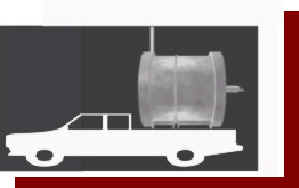- The problem
solved: Processing
of carcass in case of animals' die
off
-
Definition:
The
basic element of this process is a rotating incineration. It consists of
three or more partitioned, rotating space for carcasses. The turnaround
time of the segments is the same as the required incineration time. The
equipment can be operated as a fixed or mobile installation. The next step
of recycling process is the chemical modification of the ashes, which is
produced phosphorous fertilizer and no harmful materials.
- Presentation: There are several cylindrical cremating channels within an external cover sheet under heat insulation, rotated around an axis, in the internal surface of which the cremating units move around on a rolling rack that are kept in a horizontal position by gravity. It is possible install 3, 6 or 12 cremating channels within the external sheet with a single hole. The objective of development of the solution applied in the invention was to create a piece of equipment for permanent operation, suitable for the cremation of several carcass at a time with a single feed hole, which – depending for size – may even be a mobile piece of equipment. The equipment and technology to be presented fundamentally different from the practices so far, yet it reliability meets all relevant requirements. Exhaust gas is collected in the section between the separate cylindrical cremating units, channeled into the standing smoke collection drum through the holes in the external cover sheet of the cylinder where it can be released through a chimney via a heat exchanger after the already applied neutralizing technologies. The gas and the pre-heated hot air is lead into the equipment at the other extremity of the external rotating cylinder, enabling the feed required for the optimum temperature during permanent operation.


After a chemical modification of ashes with a diluted strong acid a fertilizer of high phosphorous content is obtained. The remanded dangerous viruses (e.g. HIV and others) in the ash of carcasses are demolished by the acidic treatment.
-
Application:
Agriculture,
livestock-farming
-
Advantages: Low energy; Consumption;
Efficiency; Security; Environment
protection
-
Stage of development:
Plan
- Available documentation: Three-dimensional film on CD, scale-model, technical process
2. The inventor:

-
Name: Földes,
Gábor
- Introduction:
3. The protection:
- Form: patent application
- Priority: 27. 10. 2003.
- Countries:
- Owner of patent: The inventor
4. Business purpose: Co-operating and/or finding investment partner and selling the patent rights.
5. Contact:
- Name: Földes Gábor
- E-mail: gabor.foldes@freemail.hu
- Fax:
- Telephone: +36 30 941 5263
- Address: H – 1114 Budapest, Bocskai út 27. Hungary
